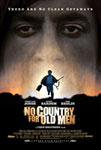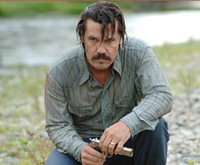2008
Main Movie
Page
Atonement
Boy in the Striped Pajamas
Brideshead Revisited
Counterfeiters
The Dark Knight
Enchanted
Frozen River
Indiana Jones and the Kingdom of the Crystal Skull
Iron Man
Juno
Man on Wire
Michael Clayton
No Country
for Old Men
Rachel Getting Married
the Savages
The Secret Life of Bees
Sweeney Todd
There Will Be Blood
The Visitor
WALL-E
Film
Reviews from 2007
Film Reviews
from 2006
The newest film from the Joel and Ethan Coen, best known for Fargo, is based on the award-winning novel by Cormac McCarthy. No Country for Old Men has been receiving great reviews, and is now winning end-of-the-year critic’s prizes of its own. It’s certainly well acted and impressively shot. It’s also pretty bloody. However, when it was over, I had no idea what to make of it. No Country is set in Texas in 1980. It follows three characters: Llewelyn Moss (Josh Brolin), who happens upon a suitcase full of money from a botched drug deal; the psychopathic killer Anton Chigurh (Javier Bardem), who is fast on Llewelyn’s tail, and Sheriff Ed Tom Bell (Tommy Lee Jones) who is trailing both of them through the border towns of West Texas. Chigurh is one of the most cold-blooded killers in recent movies, blowing away his victims with some kind of pneumatic rifle, without a trace of emotion or remorse.
Perhaps had I read McCarthy’s novel, I would have had a better sense of what to make of this mix of violence and philosophy. Without doubt, the rise of violence and the drug trade over the last few decades alarms us all. The randomness of violence and fragility of life are themes in the film. On two occasions, Chigurh forces his terrified victims to call “heads or tails” while he flips a coin to determine their fate. Yet, none of these themes is original, or explored in ways that shed any new light on them. I left the theater with more questions than answers. So, while I enjoyed some of No Country for Old Men for its technical merits, it added up to a very puzzling experience for me. I did not see the greatness in it that so many critics apparently have. I just wondered, “What was that all about?” If anyone has a clue, please let me know. Tom Condon, OP |
|
subscribe to
DomLife.org and receive a free email update every two weeks. unsubscribe |



 No Country for Old Men
No Country for Old Men Cinematically, the film is well done. A particularly suspenseful
scene involves Llewelyn in a dark hotel room, watching and listening
for Chigurh outside his door. Chigurh bursts in, and chases the
fleeing Llewelyn through the streets of the small town. Technically,
it’s a great scene, expertly photographed and edited, and eerily
silent without any background music.
Cinematically, the film is well done. A particularly suspenseful
scene involves Llewelyn in a dark hotel room, watching and listening
for Chigurh outside his door. Chigurh bursts in, and chases the
fleeing Llewelyn through the streets of the small town. Technically,
it’s a great scene, expertly photographed and edited, and eerily
silent without any background music.